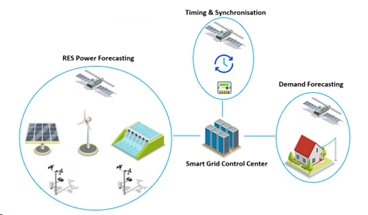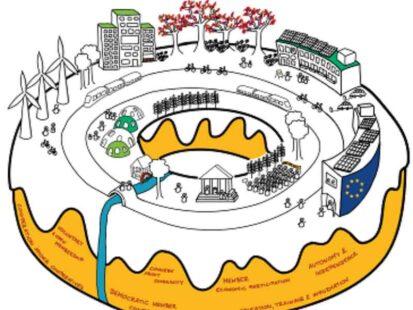
The RESPONDENT project aims to leverage space-based Earth observation data to promote the integration of renewables into Europe’s power grid, writes project communication manager Benjamin Moore.
The European Union, through its ambitious Green Deal, is committed to achieving a climate neutral and environmentally friendly economy by 2050. This comprehensive initiative encompasses bold and wide-ranging plans, with a significant focus on ensuring a clean, affordable and secure energy supply.
Addressing the urgent need for swift decarbonisation, particularly in the vast energy sector of the economy that is responsible for over 75% of the EU’s greenhouse gas emissions, is a key aspect of this commitment that must be adapted to the realities of a warming world.
Recognising the pivotal role of the energy sector in climate change, the ‘Clean Energy for all Europeans’ package emphasises the urgency of adopting sustainable practices for a viable future. The package addresses the current challenges and underscores the importance of transitioning to cleaner energy sources to mitigate the catastrophic environmental impact that is certain to engulf our world if urgent action is not taken.
Have you read?
Harnessing the power of the EU’s Space Programme for renewable energy
Assessing the Green Deal ahead of the European elections
Central to such an ambition is the successful integration of renewable energy sources (RES), a cornerstone of both the Green Deal and the Clean Energy package. The Renewable Energy Directive, part of the package, initially set a target of 40% for the share of renewable energy in the EU, later revised to up to 45% in November 2023.
These ambitious targets underscore the EU’s dedication to accelerating the adoption of renewable energy and reducing reliance on traditional fossil fuels, marking a significant step toward a greener and more sustainable future.
As the EU strives to leverage renewable sources, it confronts inherent challenges stemming from the intermittent nature of these natural energy generators. While solar, wind and hydropower offer sustainable potential in renewable energy and are an attractive alternative to fossil fuels, their weather-dependent and variable nature poses inherent challenges and can invite scepticism.
For example, the fluctuations in power output from variable renewable energy sources create integration difficulties, even with the major advancements in smart power grids that have been made in recent decades.
Space data to propel Green Deal
Enter RESPONDENT, a 30-month, Horizon Europe project that began in November 2022 and answers the call for European Global Navigation Satellite System (GNSS) and Copernicus Earth observation data applications to help propel the noble aspirations of the European Green Deal.
Helmed by Future Intelligence Ltd (FINT), a regional leader in telecom engineering products and services, the consortium comprises experts from diverse fields united in the goal of harnessing the Galileo and Copernicus space systems to seamlessly integrate renewables into the established power grids.

Comprising three main pillars, RESPONDENT strategically utilises the EU’s Galileo and Copernicus satellite systems and services to advance the European Green Deal and its associated directives.
The pillars, elaborated upon below, comprise:
- Power generation forecasting
- Prediction of power demand
- Timing and synchronisation (T&S) for smart grids.
RESPONDENT’s cutting-edge power generation forecasting module employs an AI/ML algorithm, focusing on key local weather variables and incorporating Copernicus Earth observation data and in-situ IoT sensor information.
As an extension of FINT’s weather prediction model, this algorithm achieves 8-12% greater accuracy than existing solutions. Its adaptability makes it suitable for various renewables types, catering to both large and smaller operators in power generation and the wider European energy market.

Regarding its power demand forecasting, RESPONDENT’s innovation integrates weather, historical consumption and socio-economic data into dynamic simulations. Utilising AI/ML and multi-physics simulations, the solution ensures less than a 15% deviation from actual/simulated data, providing adaptability and reliability across diverse circumstances and consumer populations, namely industrial commercial, and residential.
Designed for seamless integration into both legacy and modern systems, it promises highly effective forecasting results.

Lastly, the RESPONDENT project’s third innovation lies in its smart grid timing and synchronisation (T&S) module, fully leveraging Galileo timing and synchronisation services.
Integrating Galileo receivers into commercial off-the-shelf phasor measurement unit (PMU) devices, the project introduces a new Galileo-enabled T&S functionality for grid operations. Galileo’s precise time reference ensures sub-microsecond accuracy, minimising timing losses and enhancing grid resilience against interference and attacks, resulting in enhanced smart grid balancing.
With this module, RESPONDENT anticipates a 50% reduction in timing losses and a 95% improvement in immunity against potential attacks.

Integrating and piloting RESPONDENT solutions
To ensure a secure and seamless power supply and grid stability, RESPONDENT integrates power generation/demand forecasting with Galileo-enabled PMU signal monitoring. This integration provides a cost-effective solution for smart grid management, featuring standardised interfaces for easy integration into existing grid infrastructure.
The solution not only offers precise monitoring and forecasting capabilities but also lays the foundation for Galileo-enabled smart grids, enhancing timing accuracy and eliminating vulnerabilities, all while reducing costs by 30%.
While a discussion of the theoretical capabilities that the RESPONDENT project has to offer, practical demonstrations and validations are equally crucial for the adoption of its solutions in the real world. To achieve this, two pilots have been scheduled for the RESPONDENT project.
Pilot 1, focusing on renewable power generation forecasting, is set to take place at consortium partner Kiefer’s solar PV park in Artemida, near Athens, towards the end of 2024. The primary objective of this pilot will be to validate the AI/ML algorithm under real-world conditions, incorporating local weather data and actual power generation data from the solar park.
Pilot 2, which centres on smart grid timing and synchronisation, balancing and monitoring, will be conducted in Catalonia in Spain in early 2025. This pilot aims to validate the Galileo-based T&S scheme and the PMU monitoring module.
Simulations using the PyPSA-Eur energy system optimisation model and the demonstration of power demand forecasting will be carried out at the headquarters of partner VICOMTECH in San Sebastian.
These distinct pilots, covering different locations and aspects of the project, contribute collectively to the overall validation of the RESPONDENT platform, ensuring its reliability and applicability in a diverse range of scenarios.
Pivotal for the energy transition
In navigating the winding path toward a sustainable and decarbonised energy future, initiatives like RESPONDENT and its groundbreaking solutions stand out as pivotal players in the transition. By amalgamating state-of-the-art technologies and harnessing Earth observation capabilities, RESPONDENT establishes the foundation for a resilient and efficient energy ecosystem, in perfect harmony with the EU’s commitment to a greener future.
With a comprehensive approach tackling challenges in forecasting, smart grid integration and precise timing, RESPONDENT is poised to make a significant contribution, propelling Europe to the forefront of global endeavours towards achieving a sustainable and carbon-neutral energy landscape.
About the author:
Benjamin Moore is an EU project manager with Carr Communications Ltd and serves as the Dissemination and Communication Manager for the Horizon Europe project RESPONDENT.



